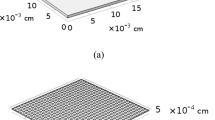Abstract
Abstract
Surface exchange reactions and chemical diffusion in composites, consisting of a dilute distribution of inclusions in a matrix, and polycrystalline materials have been modelled by application of both a square grain and a spherical grain model. The diffusion equations have been solved numerically by employing a finite element approach in the case of the square grain model and the Laplace transform method involving numerical Laplace inversion with respect to the spherical grain model. The boundary conditions refer to oxygen exchange reactions between a gas phase and a mixed ionically–electronically conducting ceramic sample within the linear response regime, i.e. small variations of the oxygen partial pressure. Diffusion profiles as well as the time dependence of the total amount of exchanged oxygen (relaxation curves) have been calculated. A necessary requirement for effective medium diffusion is proposed, and appropriate relations for the effective chemical surface exchange coefficient and the effective chemical diffusion coefficient are derived. On the contrary, when the time constant for diffusion from the matrix into the inclusions of a composite exceeds considerably the relaxation time for effective medium diffusion, relaxation curves with two separate time constants are observed. Analogously, in the case of polycrystalline materials the overall transport process is determined by slow (rate-limiting) bulk diffusion from the grain boundaries into the grains. Adequate formulae for the relaxation times are given based on analytical approximations of the solution functions to the diffusion equations. In addition, the spherical grain model is applied to interpret the re-oxidation kinetics of the positive temperature coefficient of resistivity (PTC) ceramics based on conductivity relaxation experiments.
Graphical abstract







Similar content being viewed by others
References
Maier J (1995) Prog Solid St Chem 23:171
Kaur I, Mishin Y, Gust W (1995) Fundamentals of grain and interphase boundary diffusion. Wiley, Chichester
Huybrechts B, Ishizaki K, Takata M (1995) J Mat Sci 30:2463
Hennings DFK (1995) J Eur Ceram Soc 21:1637
Gupta TK (1990) J Am Ceram Soc 73:1817
Merkle R, Maier J (2008) Angew Chem Int Ed 47:3874
Steele BCH (2000) Solid State Ionics 129:95
Steele BCH, Hori KM, Uchino S (2000) Solid State Ionics 135:445
Ji Y, Kilner JA, Carolan MF (2005) Solid State Ionics 176:937
Fisher JC (1951) J Appl Phys 22:74
Whipple RTP (1954) Philos Mag 45:1225
Suzuoka T (1961) Trans Jap Inst Metals 2:25
Gilmer GH, Farrell HH (1976) J Appl Phys 47:3792
Gilmer GH, Farrell HH (1976) J Appl Phys 47:4373
Preis W, Sitte W (1996) J Appl Phys 79:2986
Preis W, Sitte W (2005) J Appl Phys 97:093504
Levine HS, MacCallum CJ (1960) J Appl Phys 31:595
Bokshtein BS, Magidson IA, Svetlov IL (1958) Phys Met Metallogr 6:81
Preis W, Sitte W (2005) J Phys Chem Solids 66:1820
Preis W, Sitte W (2008) Solid State Ionics 179:765
Gryaznov D, Fleig J, Maier J (2006) Solid State Ionics 177:1583
Gryaznov D, Fleig J, Maier J (2008) Solid State Sci 10:754
Jamnik J, Maier J (1997) Ber Bunsenges Phys Chem 101:23
Jamnik J, Maier J (1998) J Phys Chem Solids 59:1555
Leonhardt M, Jamnik J, Maier J (1999) Electrochem Solid-State Lett 2:333
Chung Y-C, Kim CK, Wuensch BJ (2000) J Appl Phys 87:2747
Harrison LG (1961) Trans Faraday Soc 57:1191
Mishin YM, Herzig C (1995) NanoStruct Mater 6:859
Hwang JCM, Balluffi RW (1979) J Appl Phys 50:1339
Le Claire AD (1963) Brit J Appl Phys 14:351
Chung Y-C, Wuensch BJ (1996) J Appl Phys 79:8323
Gryaznov D, Fleig J, Maier J (2008) J Appl Phys 103:063717
Kalnin JR, Kotomin EA, Maier J (2002) J Phys Chem Solids 63:449
Jamnik J, Kalnin JR, Kotomin EA, Maier J (2006) Phys Chem Chem Phys 8:1310
Belova IV, Murch GE (2004) Phil Mag 84:17
Belova IV, Murch GE (2005) J Phys Chem Solids 66:722
Kidner NJ, Perry NH, Mason TO, Garboczi EJ (2008) J Am Ceram Soc 91:1733
McLachlan DS, Blaszkiewicz M, Newnham RE (1990) J Am Ceram Soc 73:2187
Bunde A, Dieterich W (2000) J Electroceramics 5:81
Knauth P (2000) J Electroceramics 5:111
Jonscher AK (1983) Dielectric relaxation in solids. Chelsea Dielectric Press, London
Barsoukov E, Macdonald JR (2005) Impedance spectroscopy, 2nd edn. Wiley, Hoboken
Wagner C (1975) Prog Solid State Chem 10:3
Heyne L (1977) Solid electrolytes. In: Geller S (ed) Topics in applied physics, vol 21. Springer, Berlin, p 169
Maier J (1998) Solid State Ionics 112:197
Crank J (1975) The mathematics of diffusion. Oxford University Press, Oxford
Leonhardt M, De Souza RA, Claus J, Maier J (2002) J Electrochem Soc 149:J19
Carslaw HS, Jaeger JC (1959) Conduction of heat in solids. Clarendon Press, Oxford
Preis W, Sitte W (2006) Solid State Ionics 177:3093
Preis W, Sitte W (2006) Solid State Ionics 177:2549
Author information
Authors and Affiliations
Corresponding author
Rights and permissions
About this article
Cite this article
Preis, W. Modelling of surface exchange reactions and diffusion in composites and polycrystalline materials. Monatsh Chem 140, 1059–1068 (2009). https://doi.org/10.1007/s00706-009-0124-8
Received:
Accepted:
Published:
Issue Date:
DOI: https://doi.org/10.1007/s00706-009-0124-8




